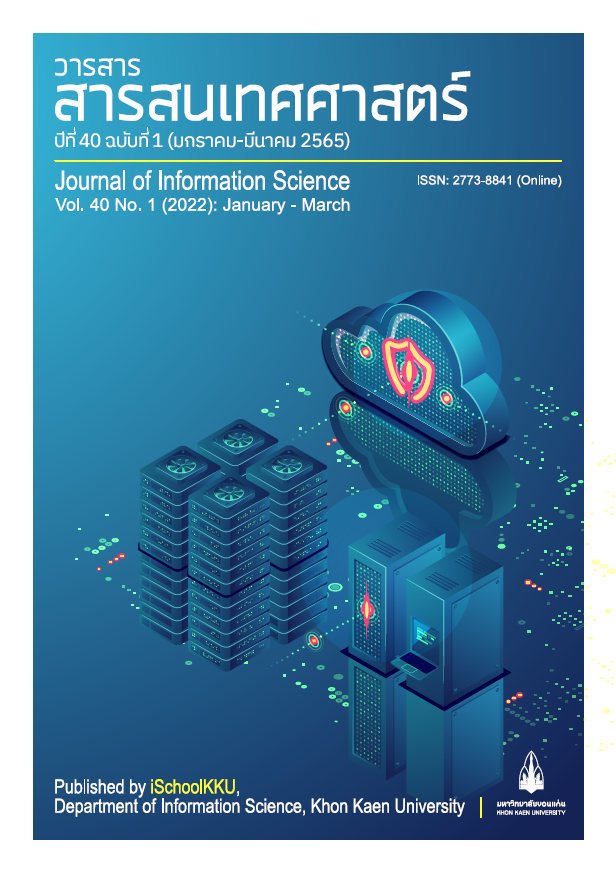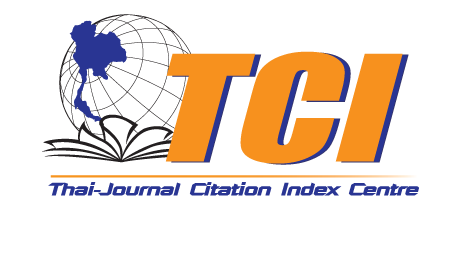การ จำแนกข้อร้องเรียนรถโดยสารสาธารณะด้วยการเรียนรู้เชิงลึก
DOI:
https://doi.org/10.14456/jiskku.2022.2คำสำคัญ:
การจำแนกข้อความ, การเรียนรู้ของเครื่อง, การเรียนรู้เชิงลึก, รถโดยสารสาธารณะบทคัดย่อ
วัตถุประสงค์: เพื่อออกแบบและพัฒนาการจำแนกข้อร้องเรียนรถโดยสารสาธารณะด้วยการเรียนรู้เชิงลึก และเพื่อประเมินความถูกต้องของผลการจำแนกข้อร้องเรียนรถโดยสารสาธารณะ
วิธีการศึกษา: ออกแบบและพัฒนาการจำแนกข้อร้องเรียนรถโดยสารสาธารณะด้วยการเรียนรู้เชิงลึก เพื่อสร้างโมเดลการจำแนกแบบไบนารี่ โดยแบ่งคำด้วยอัลกอริทึม deepcut จากนั้นจะแปลงข้อมูลทั้งหมดไปอยู่ในถุงคำ สำหรับนำมาสร้างดัชนีคำศัพท์ที่สามารถคำนวณค่าน้ำหนักคำสำคัญสำหรับการจำแนกข้อความ และลดปัญหาความซ้ำซ้อนของข้อมูลด้วย t-SNE เพื่อนำผลการกระจายตัวของกลุ่มที่มีความคล้ายคลึงกันมาสร้างคลาสการร้องเรียน แบ่งออกเป็น 7 คลาส ได้แก่ คลาสการขับขี่ คลาสการจอดรับส่ง คลาสผู้ให้บริการ คลาสการเดินรถ คลาสยานพาหนะ คลาสอุปกรณ์ให้บริการ และคลาสมาตรการป้องกันโรคระบาด ตามบริบทการให้บริการรถโดยสารสาธารณะ
ข้อค้นพบ: การจำแนกข้อร้องเรียนรถโดยสารสาธารณะด้วยการเรียนรู้เชิงลึกด้วยอัลกอริทึม deepcut ฝึกฝนโมเดลด้วยการวิเคราะห์การถดถอยโลจิสติกส์ พบว่า ทุกคลาสมีความถูกต้องมากกว่าร้อยละ 90 อย่างไรก็ดี ค่าความถูกต้องในคลาสผู้ให้บริการ มีความถูกต้องเพียงร้อยละ 83 ตามจำนวนข้อร้องเรียนในคลาสที่เยอะที่สุด ส่งผลให้เกิดความหลากหลายของข้อมูลที่แตกต่างกันตามบริบทของผู้ใช้ เมื่อเปรียบเทียบกับอัลกอริทึม fastText พบว่า ค่าความถูกต้องของทั้งสองอัลกอริทึมมีค่าความถูกต้องอยู่ในระดับสูง และเป็นไปในทิศทางเดียวกัน ผลการประเมินผลความถูกต้องจากการติดแท็กปัญหาการให้บริการ พบว่า อยู่ในระดับดีมาก แสดงถึงการจำแนกข้อร้องเรียนรถโดยสารสาธารณะด้วยการเรียนรู้เชิงลึก ให้ผลลัพธ์ความถูกต้องในระดับสูง โดยเฉพาะข้อร้องเรียนแบบ 1 ประเด็นต่อ 1 ข้อร้องเรียน เนื่องจากเหมาะกับคำศัพท์ที่บริบทสามารถกำหนดขอบเขตได้แน่นอน ในทางกลับกัน ปัญหาที่พบส่วนใหญ่ เนื่องมาจากมีคำศัพท์ที่ซ้ำซ้อนกันในบางคลาส เช่น เสียงดัง ที่จำเป็นต้องดูบริบทของข้อความประกอบ เนื่องจากเสียงดังเป็นกิริยาที่อาจเกิดจากบุคคลในคลาสการขับขี่ หรืออาจเป็นเสียงที่เกิดจากเครื่องยนต์จากคลาสยานพาหนะ หรือคลาสอุปกรณ์ให้บริการก็เป็นได้ ดังนั้นการวัดความถูกต้อง นอกจากจะวัดในเชิงความหมายแล้ว ยังต้องวัดในบริบทของการใช้งานด้วย
การประยุกต์ใช้จากการศึกษานี้: ผลลัพธ์จากงานวิจัยจะนำเสนอแนวทางการจำแนกข้อความด้วยการเรียนรู้เชิงลึก และเป็นประโยชน์แก่ผู้รับผิดชอบ เพื่อนำไปปรับปรุงการให้บริการให้เหมาะสมกับความต้องการของผู้ใช้บริการต่อไป
Downloads
References
Aggarwal, C. C. (2015). Data classification algorithms and applications. Boca Raton, FL, USA: CRC Press.
Albon, C. (2018). Machine learning with python cookbook practical solutions from pre-processing to deep learning. Sebastopol, CA, USA: O'Reilly Media Inc.
Bangkok Mass Transit Authority. (2019). Annual report 2019. (In Thai), Bangkok: Bangkok Mass Transit Authority, Bangkok.
Bhattacharjee, J. (2018). Fast text quick start guide get started with facebook's library for text representation and classification. Birmingham, UK: Packt Publishing.
Jo, T., (2019). Text mining concepts, implementation, and big data challenge. Cham, Switzerland: Springer International Publishing.
Kleinbaum, D. G. & Klein, M. (2010). Logistic regression a self‐learning text. 3rd ed. New York, USA: Springer Science+Business Media LLC.
Manning, C.D., Raghavan, P., & Schütze, H., (2008). Introduction to information retrieval. Cambridge, UK: Cambridge University Press.
McConnell, S. (1996). Rapid development: taming wild software schedules. Washington, DC, USA: Microsoft Press.
Mikolov, T., Sutskever, I., Chen, K., Corrado, G. & Dean, J. (2013). Distributed representations of words and phrases and their compositionality. proceedings of the 26th international conference on neural information processing systems. (3111-3119). New York, USA: Curran Associates.
Mikolov, T., Corrado, G., Chen, K. & Dean, J. (2013). Efficient estimation of word representa-tions in vector space. proceedings of the international conference on learning representations. (1-12). Scottsdale, Arizona, USA: arXiv.
Mitchell, R. (2015). Web scraping with python: collecting data from the modern web. Sebastopol, CA, USA: O'Reilly Media Inc.
Office of Transport and Traffic Policy and Planning. (2018). The number of passengers on the BMTA bus. (In Thai). Retrieved 20 August 2021, from http://mistran.otp.go.th/mis/Interview_HIPubilcBus.aspx.
Raschka, S. & Mirjalili, V. (2017). Python machine learning machine learning and deep learning with python, scikit-learn, and tensorflow. 2nd ed. Birmingham, UK: Packt Publishing.
Rosebrock, A. (2017). Deep learning for computer vision with python: starter bundle. n.p., USA: PyImageSearch.
Scikit-learn developers (BSD License). (2020). Sklearn. manifold.TSNE. from https://scikit-learn.org/stable/modules/generated/sklearn.manifold.TSNE.html. Retrieved 5 August 2021.
Tapsai, C., Unger, H., & Meesad, P., (2021). Thai natural language processing word segmentation, semantic analysis, and application. Cham, Switzerland: Springer International Publishing.
van der Maate, L. & Hinto, H. (2008). Visualizing data using t-SNE. Journal of Machine Learning Research, 9, 2579-2605.
Vasilev, I., Slater, D., Spacagna, G., Roelants, P. & Zocca, V. (2019). Python deep learning exploring deep learning techniques and neural network architectures with pytorch, keras, and tensorflow. 2nd ed. Birmingham, UK: Packt Publishing.
Verma, A. & Ramanayya, T.V. (2015). Public transport planning and management in developing countries. Boca Raton, FL, USA: CRC Press.
Wozniak, M. (2014). Hybrid classifiers methods of data, knowledge, and classifier combination. Heidelberg, Germany: Springer-Verlag.
Zhai, C. & Massung, S. (2016). Text data management and analysis: a practical introduction to information retrieval and text mining. New York, USA: ACM Books.
Zizka, J., Darena, F., & Svoboda, A., (2020). Text mining with machine learning principles and techniques. Boca Raton, FL, USA: CRC Press.
Zong, C., Xia, R. & Zhang, J. (2021). Text data mining. Tsinghua, Beijing, China: Tsinghua University Press.





